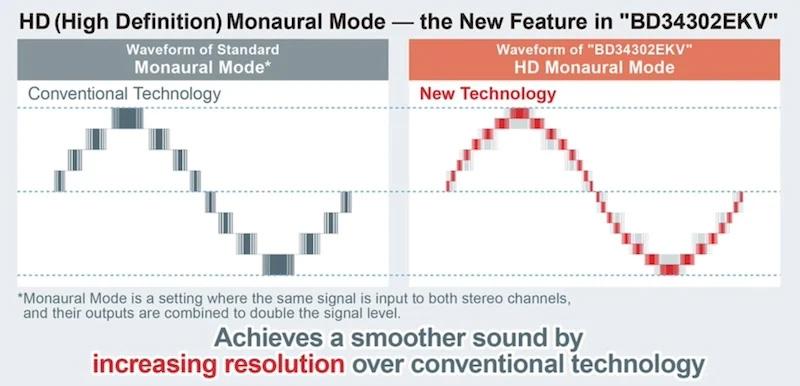
Rohm Reveals 32-bit Audio DAC Tuned for High-Resolution Playback
Rohm Semiconductor recently revealed a new 32-bit DAC IC, the BD34302EKV, to its MUS-IC series. The second generation IC builds on the successes of its predecessor, the BD34301EKV, and targets use in high-resolution audio playback. Rohm claims that its audio DAC operates by a core principle: by maintaining a natural flat sound and supplementing it with spatial reverberation, quietness, and dynamic range, Rohm DACs can reproduce the “texture” of musical instruments authentically. This allows the new IC to provide a more realistic audio experience.

The BD34302EKV.
Current high-resolution audio sources often have sampling frequencies above 96 kHz and a bit depth of 24 bits or more. Typical CD audio is played at 44.1-kHz sampling with 16-bit depth. Rohm designed the new BD34302EKV for audio applications requiring such hi-res capability.
The Flagship DAC IC Leverages DWA Algorithms
Audio equipment uses a key performance metric, total harmonic distortion + noise (THD+N), to indicate how accurately the waveform is reproduced. THD+N measures the ratio of harmonics to the fundamental wave. Smaller THD+N means more faithful reproduction.
The BD34302EKV (datasheet linked) incorporates a new algorithm for data-weighted averaging (DWA). DWA algorithms balance mismatches between elements when operating multiple switches during analog conversion. The new IC achieves a THD+N of -117 dB, an improvement over its predecessor, which had a THD+N of -115 dB. The BD34302EKV also maintains a signal-to-noise ratio (SNR) of 130 dB.

Functional block diagram of the BD34302EKV.
The BD34302EKV includes other features found in a flagship DAC chip. It operates on a two-wire interface for register settings. It supports both PCM and DSD audio formats. In PCM mode, it supports sampling frequencies from 32 kHz to 1,536 kHz, an improvement from the first generation IC’s frequencies from 32 kHz to 768 kHz. Users can select between two digital FIR filters in PCM mode for more noise control. The DSD clock supports operation at 2.8/5.6/11.2/22.5 MHz. The DAC supports up to two channels at 32-bit resolution for additional audio precision.
HD Monaural Mode Provides New Sound Texture
The BD34302EKV operates in a new High-Definition (HD) Monaural Mode. The typical stereo with two-channel operation uses a single DAC for both channels. An application device employing ST's Monaural Mode allocates a DAC chip to each channel, improving resolution and output. The DAC’s two stereo channels are fed the same input signals. The IC can then combine the two to provide higher output levels and contribute to smoother sound.

Rohm’s new HD Monaural Mode available on the BD34302EKV.
Rohm claims that the new proprietary HD Monaural Mode improves bit resolution by using digital signal processing technology behind the scenes. This enhances numerical performance and leads to smoother audio and enhanced sound quality.
The BD34302EKV maintains many of the specs of the first-generation product in this line. With the new DWA and HD Monaural features, Rohm is pushing the BD34302EKV for more uses in hi-res audio. The BD34302EKV currently comes in an HTQFP64BV package (12.0 mm x 12.0 mm x 1.0 mm). An evaluation board is available for anyone hoping to try the new DAC out.

